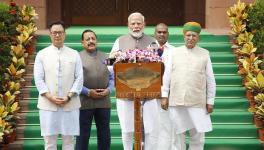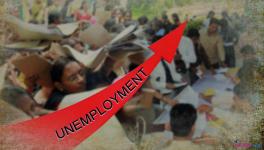A Modest Tax on Billionaires Can Ensure Basic Economic Rights to All

Image for representational use only.Image Courtesy : The Citizen
The basic income scheme that is in the air these days, which amounts to handing over a certain sum of money to every household to ensure that it reaches a threshold cash income, is an extremely flawed scheme. Instead of enjoining upon the state the obligation to provide essential goods and services like food, education, and health, to its citizens, it absolves the State of all such responsibility, once it has handed over a certain amount of money, an amount moreover which is not truly indexed to prices and whose transfer is usually accompanied by a withdrawal of existing subsidies and welfare expenditures. Besides, even conceptually, cash transfers amount to a largesse given by the State, while what should be insisted upon is the right of every citizen to a minimum standard of material life which the State has a duty to provide.
Whenever this issue of economic rights of citizens, on a par with the political rights enshrined in the Constitution, is raised, the question is typically asked: where are the resources for it? Such a question, of course, is never raised when the Budget hands over huge amounts as concessions to capitalists, ostensibly to boost their “animal spirits” so that they can invest more and raise the growth rate. It comes up only when raising the people’s living standards is under discussion. Still, no matter how dishonest the questioners’ intent, it is worth providing a rough answer to this question. This is given below.
Let us take five basic universal and justiciable economic rights: right to food, right to free publicly-provided quality healthcare through a National Health Service, right to free publicly provided quality education, right to employment, and right to adequate old-age pension and disability benefits. And let us see how much these rights would cost. We shall examine only the additional expenditure over and above what is already spent on some of these items at present, as if we are taking a snapshot picture today. These estimates rely on the work of many independent researchers, who are not specifically named.
It has been estimated that for providing employment for 100 days per household to 37.5 million urban households (living in towns with population less than one million), the total cost, including both wages and material costs (in the ratio 50:50), at wage rates which vary according to skill-level, Rs.300 per day for the bottom 30%, Rs. 500 for the next 30% and Rs.700 for the next 20% (the top 20% are assumed not to avail of such work) will be Rs. 2.8 lakh crore per annum. In rural areas, if the rural job guarantee scheme, MGNREGS, is actually made to provide 100 days of employment to every job-card holder at a wage rate of Rs. 200 per day, then the total cost would be Rs. 2.3 lakh crores. The two schemes together, urban and rural, add up to Rs. 5.1 lakh crore. Since Rs. 60,000 crore is the current allocation for MGNREGS (Mahatma Gandhi National Rural Employment Guarantee Scheme) in the Central Budget, the additional amount required is Rs.4.5 lakh crore.
We have taken only 100 days of employment per household, and that too only for job-card holders in rural areas, and in towns below one million population in urban areas. This is not the same as ensuring a right to employment for every individual citizen, which is our aim. But there will be no more than two employment-seeking individuals per household (children will be in school anyway in the new situation), and the number of days of actual employment demanded, which will be in addition to the employment they already have (and this will increase because of the institution of the other rights), will perhaps be less than 100 on average. In fact in urban areas, it is unlikely that two individuals in 80% of households will be demanding 100 days of employment each. Considering all these factors which act in contrary directions, we can perhaps take this figure of Rs.4.5 lakh crores as a first approximation to the amount that needs to be provided for instituting the right to employment as such.
As regards food, there is already a substantial food subsidy that is provided for in the budgets of the Centre and the states. The universalisation of the distribution of cheap food, considering that there will be a certain amount of voluntary drop-out, is unlikely to require more than an additional Rs.1 lakh crore.
As regards pensions, it has been estimated that 12.8 crore persons above the age of 60 will need to be catered to. Providing pensions, entirely on a non-contributory basis, at the rate of Rs. 2,000 per month to about 12.8 crore persons above the age of 60, would cost, in round figures, an additional Rs.3 lakh crore.
On education and health, instead of making specific estimates, let us assume that 6% of gross domestic product (GDP) should be provided for the former, as suggested long ago by the Kothari Commission, from the coffers of the State, and 3% of GDP should be provided for the latter, which is a benchmark suggested by many, from the coffers of the State. This would require the State’s increasing its education expenditure by 2% of GDP and its health expenditure also by 2%of GDP. These two together add up to Rs.6.6 lakh crore.
The total of all these amounts comes to Rs.15.1 lakh crore, or roughly 9% of GDP. True, there are many expenditures we have left out; but, on the other side, while our concern is with additional expenditure, we have not reckoned with current state government expenditures, which are quite substantial under many of these heads. Besides, the expenditure on some of these heads ipso facto leads to the achievement of other objectives: instituting an authentic right to education, for instance, requires large-scale construction of school buildings, which also generates employment and hence serves ipso facto to realise the right to employment. Adding up, as we have done, the requirements calculated for different heads, therefore, amounts to an overstatement. Assuming on balance that these various over-estimations and under-estimations cancel one another, we shall take Rs.15 lakh crore as the additional sum required at present for realising these five basic economic rights.
How is this sum to be raised? Let us assume that it should not be raised through any increase in the fiscal deficit, not because an increase in this deficit will have inflationary consequences, as is often claimed, but because it increases wealth inequality compared with a situation where an equivalent amount of public expenditure is tax-financed.
There is plenty of scope for raising this sum through wealth taxation. In India, shockingly, there is virtually no wealth taxation worth the name; and wealth inequality has been increasing phenomenally. According to Credit Suisse data, the top 1% of households in the country currently owns as much as 60% of total private wealth, which is higher than the figure for the US. A host of even “establishment” economists across the world have been demanding higher wealth taxation to reverse the growing inequality under neo-liberalism which they rightly see as being inimical to democracy. Even the Davos summit has expressed concern over growing wealth inequality. Wealth taxation in short is desirable per se, quite apart from its necessity for meeting welfare expenditures.
To be sure, any wealth taxation has to be a comprehensive one, complemented by taxes on gifts and transfers which would be a means of evasion. But assuming that such checks are in place, wealth taxation, precisely because it hardly exists at present, can be a potent means of resource mobilisation.
According to the Global Wealth Migration Review 2018, the total net worth of only billionaires in India amounts at present to Rs.557 lakh crore. A 1% tax on the wealth of just these billionaires will get, in round figures, Rs.5.6 lakh crore per annum.
Wealth taxation has also got to be supplemented by inheritance taxation. In fact, inheritance taxation is perfectly in sync with the ideology of capitalism. This ideology holds that capitalists owe their wealth to some special talent which they possess. But then there is no reason why their children, until they too have displayed these talents, should also be the possessors of such wealth.
If we assume that every year 5% of the total wealth of billionaires gets transferred to their children, or other legatees, as inheritance, then even a modest taxation of one-third on such inheritance would fetch Rs.9.33 lakh crore. Just these two taxes in short, and that too levied only on billionaires, will be quite enough to finance the creation of a welfare state in India in which every citizen will enjoy a set of economic rights.
Of course, we have been talking here only of money sums, while one has to consider the logical problems that may arise if taxation of a stock (wealth) is used for generating resources for an expenditure flow. But since the argument invariably is confined to the question of money sums, we have also confined ourselves to this question alone. The basic point is that the money sum required for expenditures to ensure a set of basic economic rights, can be easily raised.
Get the latest reports & analysis with people's perspective on Protests, movements & deep analytical videos, discussions of the current affairs in your Telegram app. Subscribe to NewsClick's Telegram channel & get Real-Time updates on stories, as they get published on our website.
























